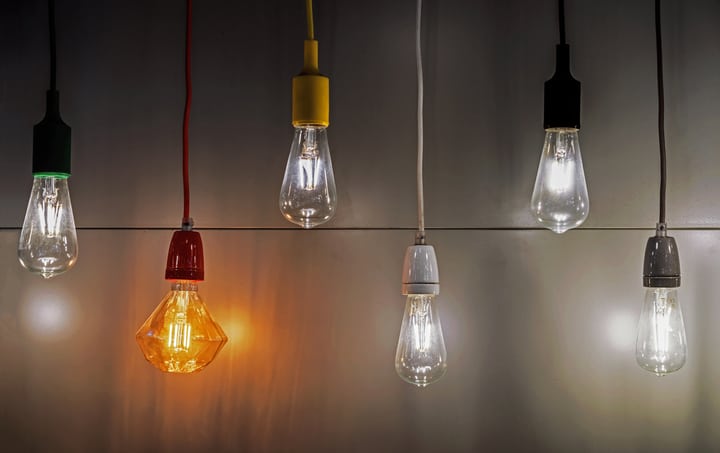Most people know that older light bulbs need a filament to work – a tiny wire heated to a high temperature until it emits light.
And because people have a basic understanding of filaments, they know that the popping sound a bulb makes when it dies is because the filament has broken.
It helps that you can usually see the broken wire inside the glass bulb.
So now that LED bulbs are becoming more popular, people want to know more about how they work – and whether they also use a filament.
Generally, LED light bulbs don’t have filaments. The light is created by a light-emitting diode, which is a semiconductor. Some LED bulbs look like they use a filament, but this is a design choice only.
In this article I’ll explain more on:
- Whether LED bulbs need a filament, and how they work
- Why some LED bulbs have a filament
- Whether filament LED bulbs are dimmable
- And if filament LEDs use more energy than normal LED bulbs
Do LED Bulbs Require Filament To Work?

LED light bulbs never need a filament to work because they instead use light-emitting diodes to generate light.
The filament creates light in an older incandescent bulb, but LEDs are completely different technology.
Let’s explain how incandescent bulbs work with a filament first so that the comparison is clear.
In an incandescent bulb, the current is passed through the wire filament to heat it to the temperature that will produce light, usually between 3,000 and 5,000 degrees Fahrenheit for a typical tungsten filament.
Of course, this means that most of the energy used for an incandescent bulb produces heat instead of light, which is why LED bulbs are much more efficient.
LEDs instead make use of a semiconductor chip. These chips are made up of positively charged electrons and negatively charged electron holes.
When a current is passed through, the two meet and give off photons, and it’s those photos that are the light source.
There’s no super-heating any thin wire filament. Instead, it’s just current passed through a chip that emits light.
Some LED light bulbs will have a single chip, but most will have multiple chips to ensure light is better directed around a room.
And it’s the material within that semiconductor that determines the wavelength of the photons emitted, which then determines the color of that photon.
So RGB light bulbs will use chips that emit the right wavelengths for red, green and blue light, with other colors created by combining these photons in different amounts.
Why Do Some LED Bulbs Have Filament?

Now that we’ve established that LED light bulbs don’t need filaments, does that mean that none of them have one?
Technically, there are no LED light bulbs that have an actual filament. By definition, a filament is a thin wire with a high melting point made incandescent by an electric current.
So if genuine LED filament bulbs don’t exist, what are “LED filament light bulbs” that you can buy in many homes and DIY stores or on any decent electrical retailer website?
Simply, they are LED bulbs designed to look like filament bulbs, either because someone wants to style their home in a cozy or retro way, or they want a particularly industrial feel to their lighting and décor.
Instead of being a wire, these ‘filaments’ are narrow tubes with small LED chips.
They work just the same as a regular LED light bulb, in that it’s the chips being illuminated. Still, because those chips are contained within tubes inside the bulb, it looks like a filament lighting up.
Because the light is contained within these thinner tubes, most LED filament bulbs have either multiple ‘filaments’ inside them or those with intricate spiral designs.
That’s to make sure there’s enough light being generated – if you had an LED bulb that used a single tube just to replicate the one small, thin wire, the amount of light it could generate would be pretty low, which would mean you’d only have limited uses for the bulb.
Are LED Filament Bulbs Dimmable?

Not all LED bulbs are dimmable. It depends on the driver, which is the component in a bulb that controls the current delivered from the mains to the light-emitting chip.
All LEDs need a driver to control that current to make sure it doesn’t get overloaded. LEDs are pretty sensitive.
It’s the driver that determines whether an LED bulb can be dimmed.
Some aren’t compatible with dimming, while others will be, though they sometimes have a minimum dimming threshold of 10% or so, which means you can dim the bulb from full brightness to 10% brightness, but no lower than that.
So back to the original question – are LED filament bulbs dimmable? Again, the same answer applies – it depends on the driver.
Some LED filament bulbs will be dimmable, and others won’t be. What matters here is that whether it’s a filament LED bulb or a standard LED bulb is irrelevant.
If you intend to use your LED filament bulb on a circuit with a dimmer switch, make sure you check the packaging or the online store listing to see whether it’s dimmable.
It’s also worth noting that if you’re buying a smart bulb from a brand like Philips Hue, who sell their own range of LED filament bulbs, then they are dimmable via the smartphone app.
Do Filament LEDs Consume More Energy Than Normal LEDs?
By now, you should be getting the idea that LED filament bulbs are the same as regular LED bulbs.
It’s just the configuration of those LED chips – whether they illuminate the whole bulb casing or just the small ‘filaments’ inside the bulb.
Therefore, you should be able to work out this answer too – whether a bulb is a filament one or not doesn’t impact how much energy it uses.
What matters is the amount and quality of the LED chip used, which can vary for filament and standard LED bulbs anyway.
It’s easy to tell whether a bulb uses more or less energy – just check the wattage.
Make sure you’re checking the actual wattage because many LED bulbs also advertise an equivalent wattage, which is the equivalent incandescent bulb brightness.
So a 4.5W LED bulb with an ‘equivalent 40W’ rating uses 4.5 Watts but is as bright as a 40 Watt incandescent bulb.
You can also work out the bulb’s efficiency if you want to make sure you’re getting the most amount of light for the least power used.
Just identify the lumens emitted by the bulb and divide it by the Watts.
So, an LED filament bulb measured at 470 lumens and rated at 4.5 Watts has an efficiency of 470 divided by 4.5 = approximately 104 lumens per watt.
Final Words
Now you know that LED filament bulbs are just a style choice.
They don’t work the same as proper incandescent filament bulbs do, but instead, just cleverly use LED tech for a look that’s a little more retro.
Otherwise, they’re just LED bulbs.
And so, the choice is yours – do you like the modern frosted-glass look of a regular LED bulb, or do you have a lamp that’d look amazing with a more industrial style one?
Let me know your preferences, as I love seeing how people can incorporate lighting choices into their décor.
Looking for an LED bulb but not sure what type you need?
Check out my free bulb picker and select the right bulb within few clicks.


